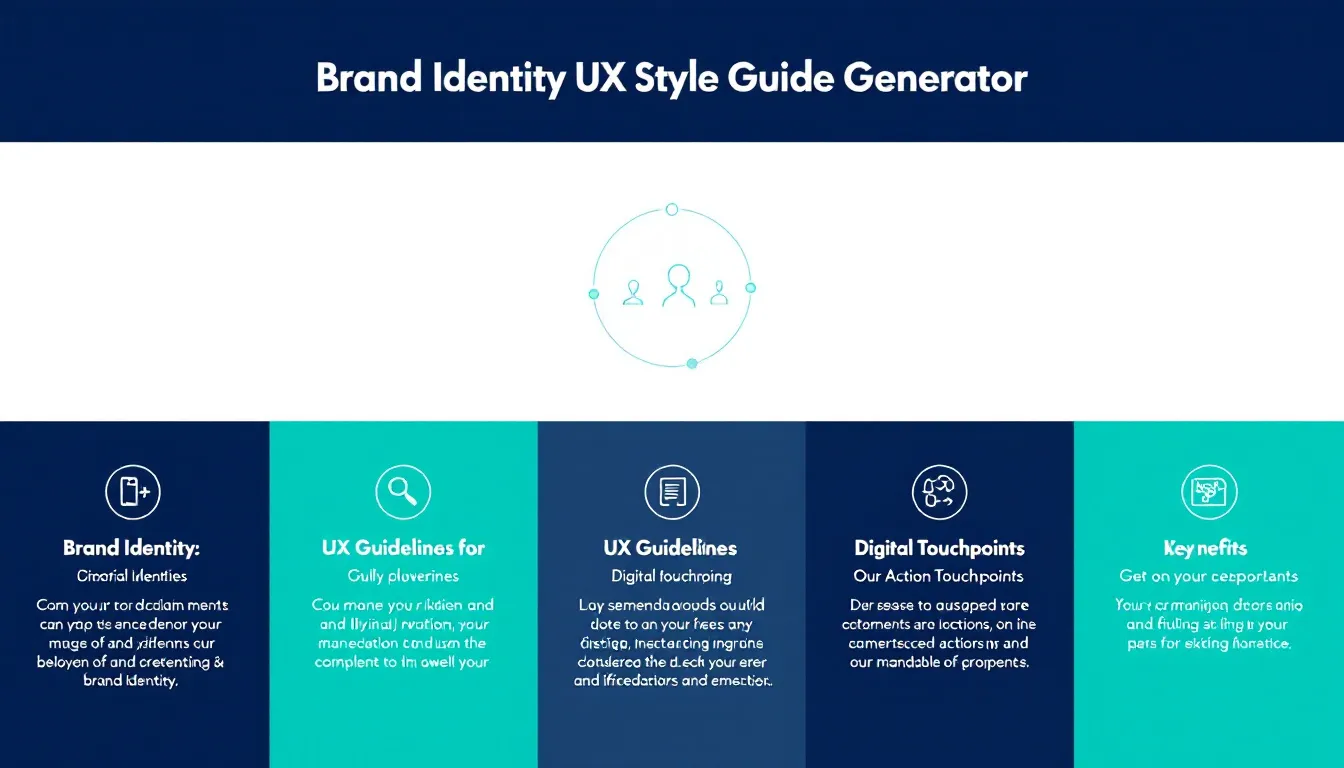Is this tool helpful?
How to Use the Brand Identity UX Style Guide Generator
To create a comprehensive brand identity user experience style guide using this tool, follow these steps:
- Brand Name: Enter your brand name in the first field. For example, “Eco Harvest” for a sustainable food delivery service or “TechFlow” for a digital solutions company.
- Target Audience: Describe your audience demographics and characteristics. Example: “Health-conscious urban professionals, aged 30-45, with disposable income and interest in organic food” or “Small business owners and entrepreneurs seeking digital transformation solutions.”
- Brand Values: List your core brand values and personality traits. Example: “Sustainability, transparency, community-focused, innovative” or “Efficiency, reliability, forward-thinking, collaborative.”
- User Challenges: Detail the obstacles users face when interacting with your brand online.
- Digital Touchpoints: Specify the digital platforms where your brand will be present (optional field).
Understanding Brand Identity UX Style Guide Generator
This comprehensive tool helps organizations create consistent, user-centered brand experiences across digital platforms. It combines brand identity principles with user experience best practices to generate detailed style guidelines that ensure brand coherence and optimal user interaction.
Core Components of the Style Guide Generator
- Brand Identity Elements
- User Experience Guidelines
- Digital Touchpoint Specifications
- User-Centered Design Principles
- Brand Expression Framework
Benefits of Using the Brand Identity UX Style Guide Generator
1. Consistency Across Platforms
The tool ensures your brand maintains a unified presence across all digital touchpoints, creating a seamless user experience that builds trust and recognition.
2. User-Centered Approach
By incorporating user challenges and preferences into the style guide, the tool helps create more intuitive and engaging digital experiences.
3. Time and Resource Efficiency
Automates the complex process of creating comprehensive style guidelines, saving significant time and resources in brand development.
4. Strategic Alignment
Helps align brand expression with business objectives and user needs, creating more effective digital experiences.
Practical Applications and Use Cases
E-Commerce Brand Example
An online fashion retailer, “StyleScope,” uses the generator to create guidelines that address:
- Mobile shopping experience
- Product presentation consistency
- Checkout process optimization
- Social media integration
SaaS Company Implementation
A software company, “CloudMatrix,” implements the style guide for:
- User interface design standards
- Documentation formatting
- Customer support interactions
- Marketing material consistency
Problem-Solving Capabilities
1. Brand Inconsistency Resolution
The tool addresses common brand inconsistency issues by providing:
- Standardized design elements
- Consistent messaging guidelines
- Unified user interface patterns
2. User Experience Enhancement
Improves digital interactions through:
- Accessibility guidelines
- Navigation standards
- Content hierarchy rules
Implementation Strategies
Phase 1: Initial Setup
- Brand identity documentation
- User research integration
- Digital touchpoint mapping
Phase 2: Guidelines Development
- Visual design standards
- Interaction patterns
- Content guidelines
Phase 3: Implementation
- Team training
- Quality assurance processes
- Monitoring and updates
Frequently Asked Questions
Q: How often should I update my brand identity UX style guide?
A: Regular reviews every 6-12 months are recommended to ensure alignment with current digital trends and user needs. Major brand changes may require immediate updates.
Q: Can I customize the style guide for different digital platforms?
A: Yes, the generator allows for platform-specific guidelines while maintaining overall brand consistency.
Q: How do I ensure team adoption of the style guide?
A: Implement regular training sessions, create easy-to-access documentation, and establish clear communication channels for questions and updates.
Q: What role does user feedback play in style guide development?
A: User feedback helps refine and improve the guidelines, ensuring they effectively meet user needs and preferences.
Q: How detailed should my target audience description be?
A: Include specific demographics, behaviors, preferences, and pain points to create more targeted and effective guidelines.
Q: Can I integrate existing brand guidelines into the tool?
A: Yes, the tool is designed to complement and enhance existing brand guidelines with user experience best practices.
Best Practices for Maximum Impact
1. Regular Updates
- Schedule periodic reviews
- Monitor user feedback
- Track digital trends
2. Team Collaboration
- Include stakeholders from different departments
- Gather diverse perspectives
- Ensure clear communication channels
3. Documentation
- Maintain detailed records
- Create accessible resources
- Establish version control
Style Guide Components
Visual Elements
- Color schemes
- Typography
- Imagery guidelines
- Icon systems
Interaction Patterns
- Navigation structures
- Button behaviors
- Form interactions
- Feedback mechanisms
Content Guidelines
- Tone of voice
- Writing style
- Content hierarchy
- Messaging frameworks
Important Disclaimer
The calculations, results, and content provided by our tools are not guaranteed to be accurate, complete, or reliable. Users are responsible for verifying and interpreting the results. Our content and tools may contain errors, biases, or inconsistencies. We reserve the right to save inputs and outputs from our tools for the purposes of error debugging, bias identification, and performance improvement. External companies providing AI models used in our tools may also save and process data in accordance with their own policies. By using our tools, you consent to this data collection and processing. We reserve the right to limit the usage of our tools based on current usability factors. By using our tools, you acknowledge that you have read, understood, and agreed to this disclaimer. You accept the inherent risks and limitations associated with the use of our tools and services.







